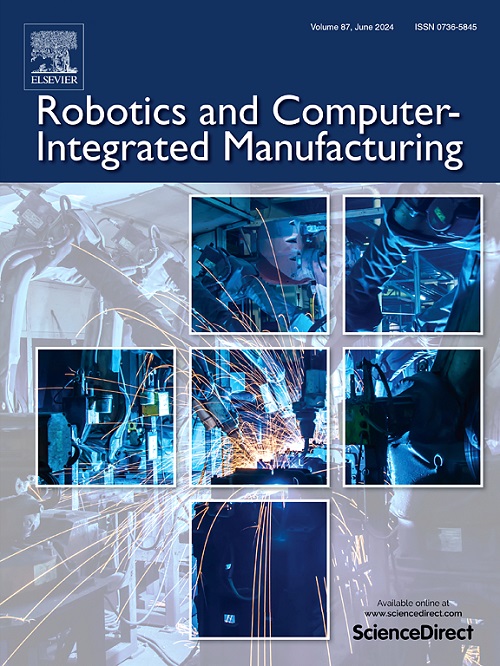一种具有均匀材料去除和各向同性纹理的自由曲面抛光的有效摆线刀具轨迹
IF 11.4
1区 计算机科学
Q1 COMPUTER SCIENCE, INTERDISCIPLINARY APPLICATIONS
引用次数: 0
摘要
各向同性抛光表面形貌(PST)和均匀材料去除(MR)是获得良好抛光表面质量和良好表面功能性能的关键。然而,目前报道的方法很少能同时保证自由曲面的均匀磁阻、各向同性PST和高抛光效率。因此,本文提出了一种新型的摆线刀具路径,可以同时优化自由曲面的抛光效率、PST各向同性和MR均匀性。在此基础上,提出了一种结合自适应齿形和改进希尔伯特曲线的抛光刀具轨迹模型,该模型具有更多可调参数、更好的多方向性、更高的随机性和平滑性。然后,提出了一个抛光性能指标,即“功率谱密度圆度”,以定量表征PST各向同性。在此基础上,进一步提出了一种综合考虑抛光效率、MR均匀性和PST各向同性的刀具轨迹优化算法。最后,通过仿真和物理抛光实验,将所提方法与现有的刀具轨迹规划方法进行了比较,验证了所提方法的有效性和优越性。结果表明,与现有方法相比,该方法的抛光效率、MR均匀性和PST各向同性分别提高了近30%、49%和20倍,这对提高自由曲面的抛光表面质量具有重要意义。本文章由计算机程序翻译,如有差异,请以英文原文为准。
An efficient trochoidal toolpath for freeform surface polishing with uniform material removal and isotropic texture
Isotropic polished surface topography (PST) and uniform material removal (MR) are the keys to achieving good polished surface quality and favorable surface functional properties. However, few methods reported thus far can ensure obtaining uniform MR, isotropic PST, and high polishing efficiency simultaneously for freeform surfaces. Therefore, this paper presents a novel trochoidal toolpath enabling simultaneous optimization of polishing efficiency, PST isotropy, and MR uniformity for freeform surfaces. With this approach, a new polishing toolpath model is proposed by combining an adaptive trochoid and an improved Hilbert curve, which has more adjustable parameters, better multi-directionality, higher randomness, and smoothness. Then, a polishing performance index, namely “PSD (Power Spectral Density) roundness”, is proposed to quantitatively characterize the PST isotropy. Based on this, a toolpath optimization algorithm with the comprehensive consideration of polishing efficiency, MR uniformity, and PST isotropy is further proposed. Finally, the proposed method was compared with existing toolpath planning methods through simulation and physic polishing experiments to demonstrate its effectiveness and superiority. The result shows that the polishing efficiency, MR uniformity, and PST isotropy are comprehensively improved by nearly 30 %, 49 %, and 20 times respectively when compared to the existing methods, which is of great significance in improving the polished surface quality for freeform surfaces.
求助全文
通过发布文献求助,成功后即可免费获取论文全文。
去求助
来源期刊
CiteScore
24.10
自引率
13.50%
发文量
160
审稿时长
50 days
期刊介绍:
The journal, Robotics and Computer-Integrated Manufacturing, focuses on sharing research applications that contribute to the development of new or enhanced robotics, manufacturing technologies, and innovative manufacturing strategies that are relevant to industry. Papers that combine theory and experimental validation are preferred, while review papers on current robotics and manufacturing issues are also considered. However, papers on traditional machining processes, modeling and simulation, supply chain management, and resource optimization are generally not within the scope of the journal, as there are more appropriate journals for these topics. Similarly, papers that are overly theoretical or mathematical will be directed to other suitable journals. The journal welcomes original papers in areas such as industrial robotics, human-robot collaboration in manufacturing, cloud-based manufacturing, cyber-physical production systems, big data analytics in manufacturing, smart mechatronics, machine learning, adaptive and sustainable manufacturing, and other fields involving unique manufacturing technologies.

 求助内容:
求助内容: 应助结果提醒方式:
应助结果提醒方式:


